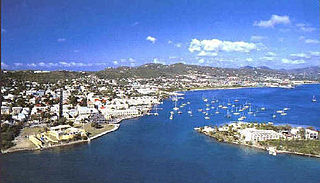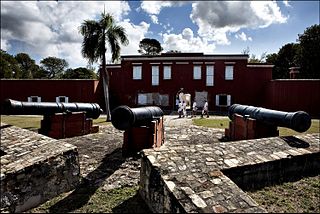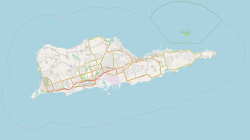
The Danish West Indies or Danish Virgin Islands or Danish Antilles were a Danish colony in the Caribbean, consisting of the islands of Saint Thomas with 32 square miles (83 km2); Saint John with 19 square miles (49 km2); and Saint Croix with 84 square miles (220 km2). The islands have belonged to the United States as the Virgin Islands since they were purchased in 1917. Water Island was part of the Danish West Indies until 1905, when the Danish state sold it to the East Asiatic Company, a private shipping company.
Saint Croix is an island in the Caribbean Sea, and a county and constituent district of the United States Virgin Islands (USVI), an unincorporated territory of the United States.

Christiansted is the largest town on Saint Croix, one of the main islands composing the United States Virgin Islands, a territory of the United States of America. The town is named after King Christian VI of Denmark.

Frederiksted is both a town and one of the two administrative districts of St. Croix, U.S. Virgin Islands. It is a grid-planned city, designed by surveyor Jens Beckfor, originally to 14x14 blocks but built 7x7 to enhance the island commerce in the 1700s. Fewer than 1,000 people live in Frederiksted proper, but nearly 10,000 live on the greater western side of the island. Christiansted is about 30 years older, but commerce was limited by its natural, shallow protective reef. Frederiksted was built in the leeward side of the island for calm seas and a naturally deep port. It is home to Fort Frederik, constructed to protect the town from pirate raids and attacks from rival imperialist nations and named after Frederick V of Denmark, who purchased the Danish West Indies in 1754.

Christiansted National Historic Site commemorates urban colonial development of the Virgin Islands. It features 18th- and 19th-century structures in the heart of Christiansted, the capital of the former Danish West Indies on St. Croix Island.

Mary Point Estate is a historic property located on the north coast of Saint John, United States Virgin Islands on Mary's Point. The plantation was added to the U.S. National Register of Historic Places on May 22, 1978.

Sugar production in the United States Virgin Islands was an important part of the economy of the United States Virgin Islands for over two hundred years. Long before the islands became part of the United States in 1917, the islands, in particular the island of Saint Croix, was exploited by the Danish from the early 18th century and by 1800 over 30,000 acres were under cultivation, earning Saint Croix a reputation as the "Garden of the West Indies". Since the closing of the last sugar factory on Saint Croix in 1966, the industry has become only a memory.
Green Kay is a settlement on the island of Saint Croix in the United States Virgin Islands. It is located 3.3 miles (5.3 km) east of Christiansted.
Grove Place is a settlement on the island of Saint Croix in the United States Virgin Islands. It was added to the National Register of Historic Places in 1978.
Sion Hill is a settlement on the island of Saint Croix, in the United States Virgin Islands.

The Friedensfeld Midlands Moravian Church and Manse are historic buildings in Christiansted, Saint Croix, Virgin Islands.

Estate Little Princess is a historic plantation site located northwest of Christiansted in Saint Croix, U.S. Virgin Islands. It was first owned by governor Frederik Moth in 1738 and rests on 25 acres of land. As of 2011 the estate is under ownership of The Nature Conservancy and serves as headquarters for the Eastern Caribbean/Virgin Islands programs. The property has been turned into a nature preserve and historical tours are given as well. The site was listed on the National Register of Historic Places on June 9, 1980.

U.S. Virgin Islands Governor's Mansion may refer to any one of the three official residences owned by the government of the U.S. Virgin Islands and provided to the Governor of the United States Virgin Islands. One residence is located on each of the three largest inhabited islands of this U.S. territory in the Caribbean. The U.S. Virgin Islands maintains more official gubernatorial residences than any other state or territory of the United States.

The Friedensthal Mission, southwest of Christiansted in Saint Croix, U.S. Virgin Islands, was partly built by 1830. Also known as Friedensthal Moravian Church, it was listed on the National Register of Historic Places in 1978. In German, Fridensthal means "valley of peace".

The Christiansted Historic District is a 135.9 acres (0.550 km2) historic district in Christiansted, Saint Croix, Virgin Islands, which was listed on the National Register of Historic Places in 1976. It included 253 contributing buildings and two contributing sites.

St. John's Episcopal Church, historically known as St. John's Anglican Church, is a church in Christiansted, Virgin Islands. Although most of the current building dates to 1868, a church has been located on the site since the 18th century. It and its adjacent graveyard were listed on the National Register of Historic Places in 2016. It is located within the Christiansted Historic District, to which it is also a contributing property.
Slob Historic District, near Christiansted, Virgin Islands, is a historic district which was listed on the National Register of Historic Places in 1987. The listing included nine contributing buildings, three contributing structures, and a contributing site on 9 acres (3.6 ha).
Estate St. John, near Christiansted on Saint Croix in the United States Virgin Islands, was listed on the National Register of Historic Places in 1978. It has also been known as St. Jan Plantage. The listing included two contributing buildings and a contributing structure.
Estate La Reine, near Christiansted on Saint Croix in the U.S. Virgin Islands, dates from around 1750. It was listed on the National Register of Historic Places in 1980. The listing included three contributing buildings, two contributing structures, and a contributing site.

Estate Rust-Op-Twist, situated near Christiansted on the island of Saint Croix in the U.S. Virgin Islands, is a former colonial sugar plantation. It was a hub of sugar production from 1755 until the early 1900s, and is currently listed on the US National Register of Historic Places.

















